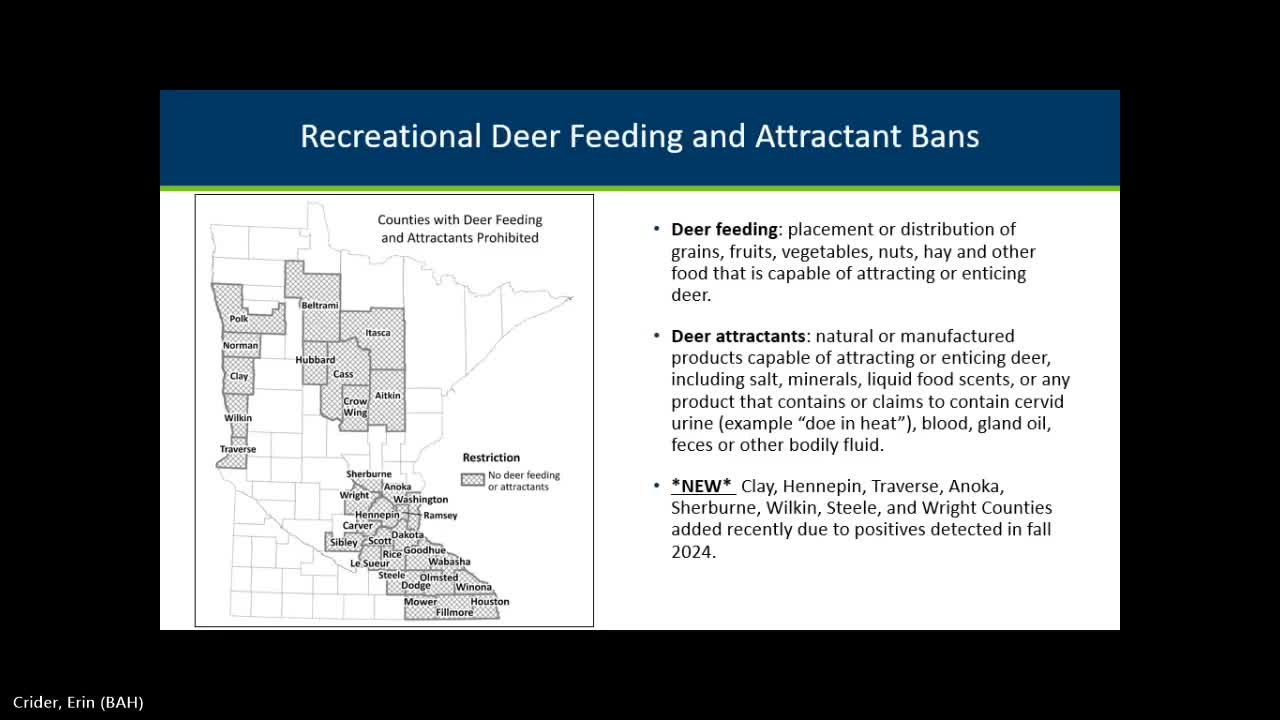Minnesota DNR conducts health pilot on wild turkey populations amid rising disease concerns
September 11, 2025 | Board of Animal Health, Agencies, Boards, & Commissions, Executive, Minnesota
This article was created by AI summarizing key points discussed. AI makes mistakes, so for full details and context, please refer to the video of the full meeting. Please report any errors so we can fix them. Report an error »

The Minnesota Board of Animal Health held its quarterly meeting on September 11, 2025, focusing on various wildlife health research projects and disease management strategies. Key discussions included updates on avian health, particularly concerning wild turkeys, and the ongoing challenges posed by high-pathogenic avian influenza (HPAI).
One significant initiative highlighted was a pilot project aimed at assessing the health of wild turkey populations in Minnesota. The project, which began in the spring, seeks to gather baseline health data amid concerns about declining turkey populations in some southeastern states. Preliminary findings indicated that while Minnesota's turkey population remains robust, there were instances of co-infection with lymphocytic disease virus and avian pox virus. The project involved collaboration with hunters and the National Wild Turkey Federation, successfully distributing 320 sampling kits to gather data on turkey health.
In addition to turkey health, the meeting addressed broader wildlife health concerns, including contamination studies in white-tailed deer and waterfowl. Research indicated significant levels of PFAS contamination in wildlife, particularly in areas known for environmental pollutants. The Board is working on expanding its surveillance efforts to monitor various wildlife species beyond chronic wasting disease, aiming to enhance data collection and management systems for better health monitoring.
The meeting also provided updates on the status of HPAI in Minnesota. The state recently declared freedom from HPAI after extensive monitoring and testing, although concerns remain regarding potential outbreaks in neighboring states. The Board is actively testing for HPAI and exploring vaccination strategies for poultry, noting that while vaccinations have reduced the impact of the virus, challenges remain in understanding their effectiveness.
Overall, the meeting underscored the importance of ongoing research and collaboration in managing wildlife health and disease, with plans for further studies and enhanced surveillance systems to protect both animal and public health in Minnesota.
One significant initiative highlighted was a pilot project aimed at assessing the health of wild turkey populations in Minnesota. The project, which began in the spring, seeks to gather baseline health data amid concerns about declining turkey populations in some southeastern states. Preliminary findings indicated that while Minnesota's turkey population remains robust, there were instances of co-infection with lymphocytic disease virus and avian pox virus. The project involved collaboration with hunters and the National Wild Turkey Federation, successfully distributing 320 sampling kits to gather data on turkey health.
In addition to turkey health, the meeting addressed broader wildlife health concerns, including contamination studies in white-tailed deer and waterfowl. Research indicated significant levels of PFAS contamination in wildlife, particularly in areas known for environmental pollutants. The Board is working on expanding its surveillance efforts to monitor various wildlife species beyond chronic wasting disease, aiming to enhance data collection and management systems for better health monitoring.
The meeting also provided updates on the status of HPAI in Minnesota. The state recently declared freedom from HPAI after extensive monitoring and testing, although concerns remain regarding potential outbreaks in neighboring states. The Board is actively testing for HPAI and exploring vaccination strategies for poultry, noting that while vaccinations have reduced the impact of the virus, challenges remain in understanding their effectiveness.
Overall, the meeting underscored the importance of ongoing research and collaboration in managing wildlife health and disease, with plans for further studies and enhanced surveillance systems to protect both animal and public health in Minnesota.
View full meeting
This article is based on a recent meeting—watch the full video and explore the complete transcript for deeper insights into the discussion.
View full meeting
